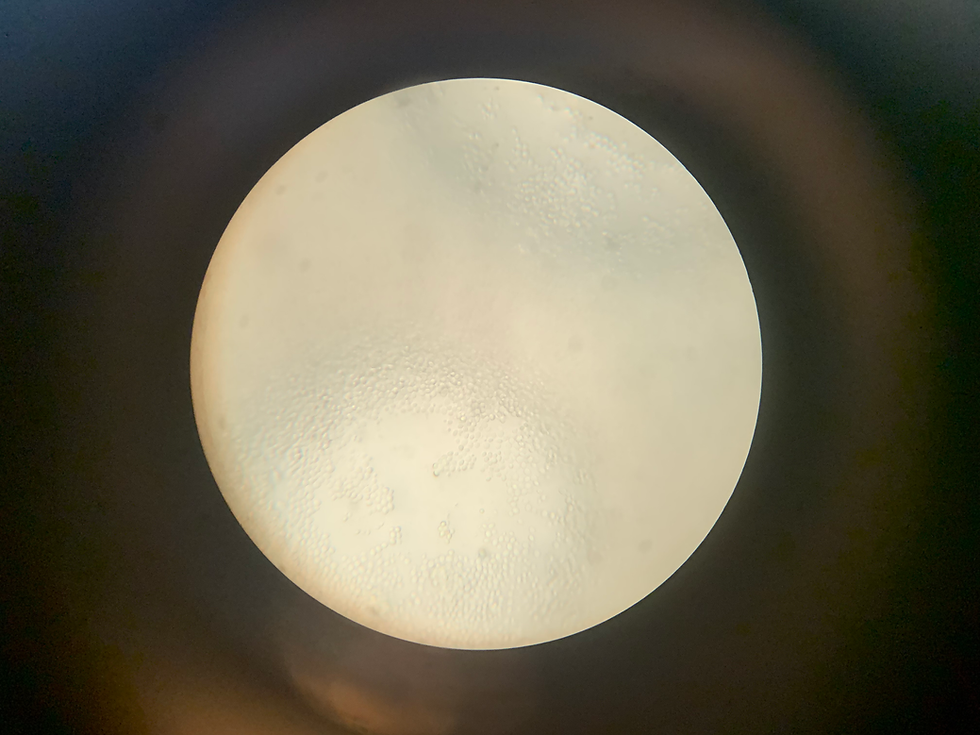Yeast. Most people understand yeast as the "thing that bread has". While that is true, there is so much more behind what yeast does. How exactly does yeast make bread dough rise? Here, we take a look at Saccharomyces cerevisiae (baker's yeast) under the microscope to explore what this yeast actually does.
Yeasts are eukaryotic and unicellular fungi. They are found worldwide in soils and on plant surfaces and are especially abundant in sugary mediums such as flower nectar and fruits.

General Background Information
Reproduction
There are two ways in which yeast can reproduce. First, yeasts can reproduce through a process called budding. A bud is formed on the outer surface of the parent cell as the nucleus divides. One nucleus migrates into the elongating bud. Cell wall material forms between the bud and the parent cell and the bud breaks away. Second, yeasts can also reproduce through a process called fission, where the parent cell splits into two equal cells.
Structure
Yeasts are around 0.075 mm in diameter. They can be a variety of shapes such as spherical to ovular. Like all fungi, they have a cell wall composed of chitin and possess a nucleus and other organelles. In many ways they represent fungi that have evolved to become ‘bacteria-like’ in their form and ecology.

Saccharomyces Cerevisiae
Saccharomyces cerevisiae, more commonly known as baker's yeast, is what most people have in their cupboards. However, there are more than 1500 different types of yeast. Instead of talking about all 1500 types of yeast, we'll be focusing on the science behind baker's yeast. Sacchromyces cerevisiae is crucial in food production, as it helps manufacture foods such as beer and bread. Specifically, its role is to ferment the food. In chemistry, fermentation refers to the metabolic process by which organic molecules (mainly carbohydrates, such as starch or a sugar) are converted into acids, gases, or alcohol.
Beer fermentation
Beer is the most consumed alcoholic beverage worldwide. It is traditionally made from four key ingredients: malted cereals, water, hops, and yeast. During beer fermentation, yeast cells convert cereal-derived sugars into ethanol and CO2. At the same time, hundreds of secondary metabolites that influence the aroma and taste of beer are produced. Variation in these metabolites across different yeast strains is what allows yeast to so uniquely influence beer flavor. In fact, it is well-known that two types of yeast are used in brewing: Sacchromyces cerevisiae as the top-fermenting yeast, and Sacchromuyces pastorianus as a bottom-fermenting yeast.
Yeast cells producing CO2
The video above shows the result of the yeast's work, CO2. When I was creating the yeast solution, I made sure I put in some sugar so the yeast could feed on it. This is how these large bubbles formed, as the yeast breaks down the sugar into CO2 gases that are displayed in the video.
Bread fermentation
The fermentation of the dough made by the yeasts is the most critical phase in the making of bread. Specifically, yeast is what makes the bread dough rise. As bread dough is mixed and kneaded, millions of air bubbles are trapped and dispersed throughout the dough.

Meanwhile, the yeast in the dough metabolizes the starches and sugars in the flour, turning them into alcohol and carbon dioxide gas. This gas inflates the network of air bubbles, causing the bread to rise.
Sources:
Briggs, George M. “Yeast.” Inanimate Life, Milne Open Textbooks, https://milnepublishing.geneseo.edu/botany/chapter/yeast/#:~:text=Structure,organelles%2C%20in%20particular%2C%20mitochondria.
“Yeast.” Encyclopædia Britannica, Encyclopædia Britannica, Inc., https://www.britannica.com/science/yeast-fungus.
Maicas, Sergi. “The Role of Yeasts in Fermentation Processes.” Microorganisms, MDPI, 28 July 2020, https://www.ncbi.nlm.nih.gov/pmc/articles/PMC7466055/#:~:text=During%20fermentation%2C%20yeast%20cells%20convert,influence%20beer%20flavor%20%5B9%5D.
Comments